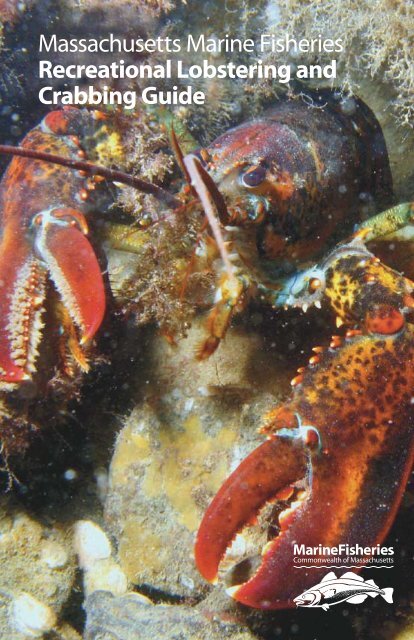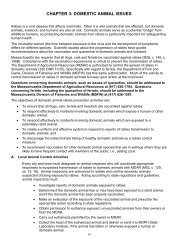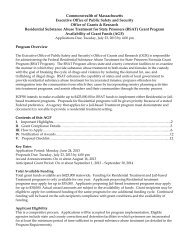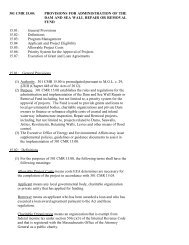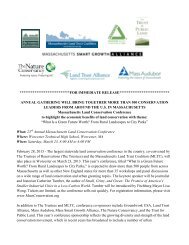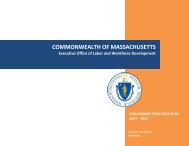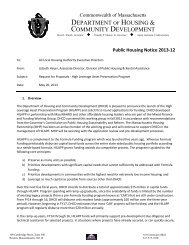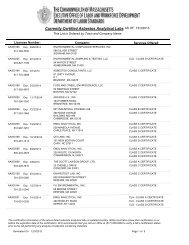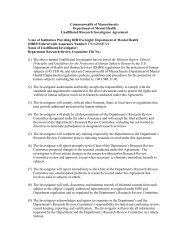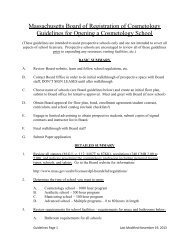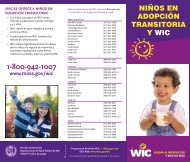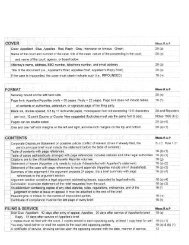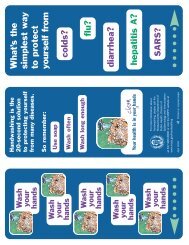Massachusetts Marine Fisheries Recreational ... - Mass.Gov
Massachusetts Marine Fisheries Recreational ... - Mass.Gov
Massachusetts Marine Fisheries Recreational ... - Mass.Gov
You also want an ePaper? Increase the reach of your titles
YUMPU automatically turns print PDFs into web optimized ePapers that Google loves.
<strong><strong>Mass</strong>achusetts</strong> <strong>Marine</strong> <strong>Fisheries</strong><br />
<strong>Recreational</strong> Lobstering and<br />
Crabbing Guide
Photo courtesy of<br />
Alison Shaw Photography
<strong><strong>Mass</strong>achusetts</strong> <strong>Marine</strong> <strong>Fisheries</strong><br />
<strong>Recreational</strong> Lobstering and<br />
Crabbing Guide<br />
Commonwealth of <strong><strong>Mass</strong>achusetts</strong><br />
<strong>Gov</strong>ernor Deval Patrick<br />
Executive Office of Energy and<br />
Environmental Affairs<br />
Secretary Ian A. Bowles<br />
Department of Fish and Game<br />
Commissioner Mary B. Griffin<br />
Division of <strong>Marine</strong> <strong>Fisheries</strong><br />
Director Paul J. Diodati<br />
www.mass.gov/<strong>Marine</strong><strong>Fisheries</strong><br />
January 2011
Table of Contents<br />
Contact Information ................................................................................ 3<br />
<strong><strong>Mass</strong>achusetts</strong> <strong>Recreational</strong> Lobster/Crabbing Areas Map ...... 4<br />
Non-Commercial Lobster/Crabbing Permit Information .......... 5<br />
Non-Commercial Regulations By Area ............................................. 6<br />
How To Measure a Lobster and a Blue Crab ..................................... 8<br />
Diving Regulations for <strong>Recreational</strong> Lobster/Crabbing ...........10<br />
All About Lobster ....................................................................................12<br />
Is It Male or Female? .....................................................................13<br />
V-Notching Regulations ..............................................................14<br />
All About Crabs ........................................................................................16<br />
Is It Male or Female? .....................................................................18<br />
All About Gear ..........................................................................................20<br />
Anatomy of a Lobster Trap .........................................................22<br />
Anatomy of a Chesapeake-style Blue Crab Trap ................23<br />
Gear Construction Requirements ...........................................24<br />
Escape Vent and Ghost Panel Placement .............................26<br />
Whale-Related Gear Rules ....................................................................28<br />
Cape Cod Bay Critical Habitat Gear Rules ......................................30<br />
Critical Habitat Area Map .......................................................... 30<br />
Every effort has been made to ensure that the contents of this document are accurate and fully updated<br />
as of the month indicated. However, in the event these summaries may differ in any way from<br />
the official rules codified at 322 Code of <strong><strong>Mass</strong>achusetts</strong> Regulations by the <strong><strong>Mass</strong>achusetts</strong> Secretary<br />
of State’s Office, or the official statutes codified in Chapter 130 of the <strong><strong>Mass</strong>achusetts</strong> General Laws,<br />
then the later versions shall apply.<br />
<strong><strong>Mass</strong>achusetts</strong> <strong>Marine</strong> <strong>Fisheries</strong> <strong>Recreational</strong> Lobstering and Crabbing Guide
Contact Information<br />
The Division of <strong>Marine</strong> <strong>Fisheries</strong> is responsible for the<br />
management of the Commonwealths living marine<br />
resources. The Division promotes and develops commercial<br />
and recreational fisheries through research, technical<br />
assistance, and the collection of statistics. For further<br />
information contact the Division Lobster Biologists.<br />
Division of <strong>Marine</strong> <strong>Fisheries</strong> Lobster Biologists<br />
Boston Office<br />
251 Causeway St., Suite 400<br />
Boston, MA 02114<br />
(617) 626-1520<br />
Fax: (617) 626-1509<br />
South Coast Office<br />
Quest Center, 1213 Purchase St.<br />
New Bedford, MA 02740<br />
(508) 990-2860<br />
Fax: (508) 990-0449<br />
Bob Glenn – Senior Biologist<br />
Annisquam River <strong>Marine</strong><br />
<strong>Fisheries</strong> Station<br />
30 Emerson Avenue<br />
Gloucester, MA 01930<br />
(978) 282-0308<br />
Fax: (617) 727-3337<br />
Tracy Pugh, Kelly Whitmore<br />
Martha’s Vineyard Office<br />
P. O. Box 68<br />
Vineyard Haven, MA 02568<br />
(508) 693-4372<br />
Fax: (508) 693-4157<br />
Office of Law Enforcement<br />
Environmental Police Officers are responsible for enforcing<br />
<strong><strong>Mass</strong>achusetts</strong> fish and game laws including the commercial<br />
and recreational harvest of living marine resources. In<br />
addition they also enforce the Commonwealth’s boating and<br />
recreational vehicle laws and regulations. Fishing violations<br />
can be reported to one of the following numbers:<br />
South Coast Bureau, Hewitts Cove ........................ (617) 727-0882<br />
Radio Room ....................................................................(617) 727-6398<br />
North Coastal Bureau ................................................. (978) 283-7764<br />
Toll free Number .........................................................1-800-632-8075<br />
<strong><strong>Mass</strong>achusetts</strong> <strong>Marine</strong> <strong>Fisheries</strong> <strong>Recreational</strong> Lobstering and Crabbing Guide
RI<br />
NH<br />
MA<br />
o 10 Miles<br />
Cape Cod Canal<br />
is part of<br />
Gulf of Maine Area<br />
<strong><strong>Mass</strong>achusetts</strong> <strong>Recreational</strong> Lobster Areas<br />
Gulf of Maine<br />
Outer Cape Cod<br />
Southern New England<br />
Closed – Outer and Inner<br />
New Bedford Harbor<br />
Location Latitude Longitude<br />
A 3 Mile-Line N 42˚ 06.92’ W 70˚ 16.64’<br />
B Race Point Buoy subject to change<br />
C Wood End Buoy subject to change<br />
D Shoreline N 42˚ 01.32’ W 70˚ 05.26’<br />
<strong><strong>Mass</strong>achusetts</strong> <strong>Marine</strong> <strong>Fisheries</strong> <strong>Recreational</strong> Lobstering and Crabbing Guide<br />
A<br />
B<br />
C<br />
D
Non-Commercial Lobster/Crabbing Permit<br />
Who can get one?<br />
U.S. Citizens and residents of the<br />
Commonwealth<br />
1. Parental consent is needed if the<br />
child is under 17 years old<br />
U.S. Citizens and non-residents of<br />
the Commonwealth who:<br />
1. Temporarily reside in any coastal<br />
city or town of the Commonwealth<br />
and…<br />
2. Own more than $5,000 in real estate<br />
within the Commonwealth as<br />
determined by tax records<br />
Non-U.S. Citizens who are not<br />
residents of the Commonwealth<br />
shall:<br />
1. Provide a copy of the alien<br />
registration receipt card issued by<br />
the U.S. Dept. of Justice,<br />
Immigration and Naturalization<br />
Service to the applicant and…<br />
2. Temporarily reside in any coastal<br />
city or town of the Commonwealth<br />
and…<br />
3. Own more than $5,000 in real estate<br />
within the Commonwealth as<br />
determined by tax records<br />
Non-U.S. Citizens who are residents<br />
of the Commonwealth shall:<br />
1. Provide a copy of applicant’s alien<br />
registration receipt card issued by<br />
the U.S. Dept. of Justice,<br />
Immigration and Naturalization<br />
Service.<br />
What does it cost?<br />
$40 for residents of the<br />
Commonwealth<br />
$60 for all non-residents<br />
Can I sell my lobsters?<br />
No. A Non-Commercial Lobster/<br />
Crabbing Permit DOES NOT allow you<br />
to sell your catch. You must obtain a<br />
Commercial Lobster/Crabbing Permit<br />
if you wish to sell your catch.<br />
Where can I get a permit?<br />
You can purchase a Non-Commercial<br />
Lobster/Crabbing Permit at any MA<br />
Division of <strong>Marine</strong> <strong>Fisheries</strong> business<br />
office<br />
or<br />
If you are a <strong><strong>Mass</strong>achusetts</strong> resident<br />
you may purchase/renew your<br />
Non-Commercial Lobster/Crabbing<br />
Permit online* *(certain restrictions apply)<br />
Please log onto:<br />
www.mass.gov/massfishhunt<br />
and follow the step by step<br />
instructions for purchasing a Non-<br />
Commercial Lobster/Crabbing Permit.<br />
How many lobsters and crabs<br />
can I take?<br />
There is a limit of 5 lobsters per day<br />
per permit, and all lobsters must meet<br />
the legal requirements. There is a limit<br />
of 5 blue crabs per day and a limit of<br />
50 crabs per day total for all edible<br />
crab species combined.<br />
Who can use the permit?<br />
A Non-Commercial Lobster/Crabbing<br />
Permit authorizes the holder and<br />
members of the holders’ immediate<br />
family, residing in the same residence,<br />
to fish for and take lobsters and edible<br />
crabs using 10 pots only. The immediate<br />
family is defined as the spouse,<br />
parents, children, grandparents,<br />
brothers and sisters of the holder. ➔<br />
<strong><strong>Mass</strong>achusetts</strong> <strong>Marine</strong> <strong>Fisheries</strong> <strong>Recreational</strong> Lobstering and Crabbing Guide 5
Non-Commercial Lobster/Crabbing Permit<br />
(continued)<br />
This permit may be endorsed for<br />
diving for the permit holder only.<br />
Other family members may purchase<br />
additional permits for diving only.<br />
Only ONE Non-Commercial Lobster/<br />
Crabbing permit endorsed for 10 pots<br />
is allowed per family/household.<br />
For what options can the<br />
permit be endorsed?<br />
When you purchase your Non-<br />
Commercial Lobster/Crabbing Permit<br />
you must specify if you want it<br />
endorsed for the use of 10 pots or for<br />
diving. Your permit can be endorsed<br />
for both practices if you prefer.<br />
Non-Commercial Regulations by Area<br />
<strong>Recreational</strong> Crab Regulations<br />
Species Blue Crab Other Edible Crabs<br />
Minimum Size 5” shell width (spine to<br />
spine)<br />
Other Regulations Egg-bearers cannot be<br />
taken; 25 crabs per day;<br />
no permit required unless<br />
using traps; closed season<br />
is 1/1–4/30, inclusive.<br />
Where can traps be set?<br />
Non-Commercial Lobster/Crabbing<br />
Permits allow you to place your traps<br />
and/or dive for lobsters in designated<br />
recreational lobster areas. Please refer<br />
to the chart on page 4.<br />
Also, no buoyed traps may be set in the<br />
Cape Cod Canal. New Bedford Harbor is<br />
closed to lobster harvest north of a line<br />
from Ricketson’s Point (Dartmouth) to<br />
Wilbur Point (Fairhaven).<br />
Annual Catch Reports<br />
Annual catch reports are required of all<br />
Non-Commercial Lobster/Crabbing<br />
Permit holders. These forms are<br />
provided by Division of <strong>Marine</strong> <strong>Fisheries</strong><br />
(<strong>Marine</strong><strong>Fisheries</strong>) at the time of renewal.<br />
Renewal licenses will not be issued until<br />
a catch report has been filed.<br />
(excludes Green Crabs)<br />
None<br />
Same as blue crab but<br />
with a 50 crab/day limit<br />
Blue Crab Jonah Crab Rock Crab<br />
<strong><strong>Mass</strong>achusetts</strong> <strong>Marine</strong> <strong>Fisheries</strong> <strong>Recreational</strong> Lobstering and Crabbing Guide
Non-Commercial Regulations by Area<br />
<strong>Recreational</strong> Lobster Regulations<br />
Gulf of Maine <strong>Recreational</strong> Lobster Area<br />
Minimum Size 31/4” Maximum Size 5”<br />
V-Notched<br />
Females –<br />
Definitions *<br />
“Zero-Tolerance” – Illegal to harvest female with<br />
V-shaped notch of any size with or without setal hairs<br />
Trap Limit 10 Traps<br />
Escape Vent 115/16” x 5 3/4” or two circular vents of 2 7/16”<br />
Bag Limit 15 per day<br />
Outer Cape Cod <strong>Recreational</strong> Lobster Area<br />
Minimum Size 3 3/8”<br />
Maximum Size —<br />
V-Notched Illegal to harvest female with notch or indentation in<br />
Females – base of flipper at least 1/4” deep and tapering to sharp<br />
Definitions point without setal hairs<br />
Trap Limit 10 Traps<br />
Escape Vent 2” x 5 3/4” or two circular vents of 2 5/8”<br />
Bag Limit 15 per day<br />
Southern New England <strong>Recreational</strong> Lobster Area<br />
Minimum Size 3 3/8”<br />
Maximum Size 51/4” V-Notched Illegal to harvest female with notch or indentation in<br />
Females – base of flipper at least 1/8” deep<br />
Definitions with or without setal hairs<br />
Trap Limit 10 Traps<br />
Escape Vent 2” x 5 3/4” or two circular vents of 2 5/8”<br />
Bag Limit 15 per day<br />
Taking Lobster at Night<br />
Lobster may only be harvested from 1/2 hour before sunrise to 1/2 hour after sunset.<br />
Egg-Bearing Females<br />
It is unlawful to take or possess any egg-bearing female lobster.<br />
It is unlawful to land or possess any lobster:<br />
. from which eggs have been removed, or…<br />
. that has come in contact with any substance capable of removing lobster eggs.<br />
<strong><strong>Mass</strong>achusetts</strong> <strong>Marine</strong> <strong>Fisheries</strong> <strong>Recreational</strong> Lobstering and Crabbing Guide
How to Measure a Lobster<br />
The Rules<br />
Lobsters must be measured with a<br />
special gauge to make sure that they<br />
are “keepers.”<br />
The carapace length is measured from<br />
the rear of the eye socket to the rear<br />
of the bodyshell (or carapace) on a<br />
line parallel to the center line of the<br />
bodyshell .<br />
All lobsters measuring less than the<br />
minimum legal carapace length, or<br />
larger than the maximum legal<br />
carapace length, must be immediately<br />
returned to the waters from which<br />
taken.<br />
All lobsters must be measured<br />
immediately upon capture. For divers<br />
this means on the seafloor before<br />
surfacing.<br />
Mutilation<br />
It shall be unlawful to possess any<br />
lobster, or part thereof, which is<br />
mutilated in a manner which makes<br />
accurate measurement impossible.<br />
Note: A common error made by<br />
novices is to measure over the rostrum<br />
or horn located above the eye socket.<br />
Make certain that your gauge is in the<br />
extreme rear of the eye socket and<br />
below the horn.<br />
➔<br />
Correct Lobster Measurement<br />
The gauge is placed in the rear of the<br />
eye socket.<br />
<strong><strong>Mass</strong>achusetts</strong> <strong>Marine</strong> <strong>Fisheries</strong> <strong>Recreational</strong> Lobstering and Crabbing Guide
How to Measure a Blue Crab<br />
5 inches<br />
The Rules<br />
Blue crabs must be measured with a<br />
special gauge to make sure that they<br />
are “keepers.” Check your local fishing<br />
supply store or Town Conservation<br />
Department for availability.<br />
The legal carapace width is 5 inches<br />
and is measured from the tip of one<br />
lateral spine to the tip of the other<br />
lateral spine across the back of the<br />
crab.<br />
All blue crabs measuring less than the<br />
minimum legal carapace width must<br />
be immediately returned to the waters<br />
from which taken.<br />
All blue crabs must be measured<br />
immediately.<br />
<strong><strong>Mass</strong>achusetts</strong> <strong>Marine</strong> <strong>Fisheries</strong> <strong>Recreational</strong> Lobstering and Crabbing Guide
SCUBA Regulations for <strong>Recreational</strong><br />
Lobster/Crabbing<br />
Permits and Conditions<br />
A Non-Commercial Lobster/Crabbing<br />
Permit endorsed for diving is required<br />
of all individuals who recreationally<br />
dive for lobsters in coastal waters. This<br />
permit also allows the taking of edible<br />
crabs.<br />
No permit is required to take edible<br />
crabs (including blue crabs) for use by<br />
immediate family if dip-netting, using<br />
“star” traps, or by diving provided that<br />
the number of blue crabs does not<br />
exceed twenty-five (25) in one day, or<br />
fifty (50) total in one day for other<br />
edible crabs, and that no 6-sided pots<br />
or traps are used.<br />
Gear Marking<br />
Divers must display their assigned<br />
permit number upon their tank and a<br />
floating marker (upright single panel<br />
at least 12” x 12”, white background,<br />
black numerals at least 3” high, ½” in<br />
thickness or width of line on both<br />
sides of the marker …or directly on<br />
their dive flag). A group of divers may<br />
use only one floating marker listing<br />
the permit number of EACH diver in<br />
the group.<br />
Catch Limits<br />
There is a limit of 5 lobsters per day<br />
per permit, and all lobsters must meet<br />
the legal requirements.<br />
Taking of blue crabs and other edible<br />
crabs is prohibited from January 1<br />
through April 30.<br />
There is a limit of 5 blue crabs per day.<br />
There is a combined limit of 50 Jonah<br />
or rock crabs per day for persons<br />
without a permit.<br />
Gear Requirements<br />
Every diver or group of divers, while<br />
swimming on or below the surface of<br />
the waters of the Commonwealth, is<br />
required by <strong><strong>Mass</strong>achusetts</strong> General<br />
Law to display a dive flag.<br />
Flag must be at least twelve inches by<br />
fifteen inches in area of red<br />
background with a white diagonal<br />
stripe.<br />
The dive flag must be displayed on a<br />
boat or surface float.<br />
It must extend at least 3 feet from the<br />
surface of the water.<br />
Divers shall remain in an area within<br />
one hundred feet of such displayed<br />
diver’s flag while at or near the surface<br />
of the water.<br />
0 <strong><strong>Mass</strong>achusetts</strong> <strong>Marine</strong> <strong>Fisheries</strong> <strong>Recreational</strong> Lobstering and Crabbing Guide
SCUBA Regulations for <strong>Recreational</strong><br />
Lobster/Crabbing (continued)<br />
Methods of Taking Lobsters<br />
and Crabs<br />
Not Allowed: <strong><strong>Mass</strong>achusetts</strong> General<br />
Laws prohibits the taking of lobsters<br />
by spearing, dipping, or dragging.<br />
Spearing – the use of a spear gun,<br />
pole spear, or any other object that<br />
may be used to pierce the shell of the<br />
lobster as a means of harvest.<br />
Dipping - the use of a dip net.<br />
Dragging - the use of mobile or<br />
hauled nets or dredges.<br />
Snares - poles with loops.<br />
Allowed: Harvesting of lobster by<br />
hand, or the use of an angled “tickle<br />
stick”, which is a straight or slightly<br />
bent stick used to agitate a lobster<br />
into coming out of its hole.<br />
Common Questions<br />
I have a 0-pot Non-commercial<br />
permit, is it automatically endorsed<br />
for diving?<br />
No. You must specify that you would<br />
like your permit to be endorsed for<br />
diving. There is no extra charge for<br />
this.<br />
Does everyone in my dive group<br />
need a permit for taking lobster?<br />
Yes. Each individual diver who intends<br />
to take lobster or crabs needs an<br />
individual permit. If diving in a group,<br />
each individuals permit number must<br />
be displayed on their tanks and on the<br />
surface floatation.<br />
Does my diving permit cover the<br />
immediate members of my family<br />
as well?<br />
No, diver permits are for the individual<br />
diver only.<br />
<strong><strong>Mass</strong>achusetts</strong> <strong>Marine</strong> <strong>Fisheries</strong> <strong>Recreational</strong> Lobstering and Crabbing Guide
All About Lobster<br />
What are they?<br />
Lobsters are ten-legged (decapod)<br />
crustaceans.<br />
The American lobster is the only species<br />
of clawed lobster in the Northwestern<br />
Atlantic region.<br />
Where are they?<br />
The American lobster is distributed<br />
throughout the Northwest Atlantic<br />
from the Straights of Bell Isle,<br />
Newfoundland to Cape Hatteras,<br />
North Carolina.<br />
They are most abundant in coastal zones<br />
at depths of less than 150 ft. (~50 m). The<br />
greatest abundance of lobster occurs<br />
within the Gulf of Maine — from midcoast<br />
Maine to Southwest Nova Scotia.<br />
Growth<br />
American lobster is a longed-lived<br />
species known to reach more than 40<br />
lbs. (18 kg ).<br />
Age is unknown because all hard parts<br />
are shed and replaced at molting,<br />
leaving no accreting material for age<br />
determination. In <strong><strong>Mass</strong>achusetts</strong>,<br />
shedding typically occurs between<br />
June and October.<br />
Lobsters at minimum legal size are<br />
generally considered to be between 5<br />
and 7 years of age based on hatchery<br />
observations.Maximum age is generally<br />
considered to be between 30 and 40<br />
years.<br />
Biology<br />
Fertilized eggs are carried on the female<br />
abdomen for a 9 to 12 month period of<br />
development prior to hatching.<br />
Female lobster carry between 1000 and<br />
>100,000 eggs depending on the size<br />
of the female.<br />
Hatching typically occurs over a 4 month<br />
period from May through September. In<br />
<strong><strong>Mass</strong>achusetts</strong> we typically see peak<br />
hatching from late-June through early-<br />
July.<br />
Egg-bearing Females<br />
It is unlawful for any fisherman to take<br />
or possess any egg-bearing female<br />
lobster or female lobster with the egg<br />
mass removed, at any time.<br />
When eggs are extruded they are<br />
dark green and the female is called a<br />
“green egger”.<br />
As eggs develop and approach<br />
hatching time they turn brown to<br />
reddish brown and the female is<br />
called a “brown egger”.<br />
<strong><strong>Mass</strong>achusetts</strong> <strong>Marine</strong> <strong>Fisheries</strong> <strong>Recreational</strong> Lobstering and Crabbing Guide
Is it Male or Female?<br />
In order to determine the sex of a<br />
lobster, you must look at the first pair<br />
of appendages under the tail, called<br />
swimmerets. They are positioned near<br />
Female<br />
The st pair of swimmerets<br />
on females are soft<br />
Female<br />
the base of the last pair of walking<br />
legs. The first pair of swimmerets are<br />
hard in the male, and soft and<br />
feathery in the female.<br />
<strong><strong>Mass</strong>achusetts</strong> <strong>Marine</strong> <strong>Fisheries</strong> <strong>Recreational</strong> Lobstering and Crabbing Guide<br />
The st pair of swimmerets<br />
on males are hard<br />
Male<br />
Male
V-Notching Regulations<br />
What is V-Notching?<br />
A “v-notch” is a mark on the tail flipper<br />
of a female lobster that was put there<br />
by commercial lobstermen as a means<br />
to identify and protect known<br />
“breeders” in the population from<br />
harvest.<br />
Commercial lobstermen make a<br />
v-notch in the tail flippers of eggbearing<br />
female lobsters they<br />
encounter while fishing.<br />
The v-notch remains in the female<br />
lobsters tail for two molts, giving<br />
them protection from harvest for up<br />
to 5 years.<br />
Below left: Newly V-notched lobster<br />
Below right and on next page are additional pictures of the newly v-notched<br />
lobster to the left, before and after it underwent two successive molts.<br />
Note that changes occurred even before the lobster molted.<br />
After Notching<br />
V-Notch<br />
Setal Hairs<br />
<strong><strong>Mass</strong>achusetts</strong> <strong>Marine</strong> <strong>Fisheries</strong> <strong>Recreational</strong> Lobstering and Crabbing Guide
V-Notching History<br />
The practice of v-notching originated<br />
in Maine, and dates back to the early<br />
1900’s.<br />
Today it is intended as a means of<br />
protecting local “broodstock”.<br />
Which Flipper is Notched?<br />
The tail flipper immediately to the<br />
right of the middle flipper, when the<br />
lobster is examined with the underside<br />
of the lobster down and its tail<br />
is toward the person making the<br />
determination.<br />
Non-Commercial Lobster/Crab<br />
Permit holders are not required to<br />
v-notch egg-bearing female<br />
lobsters.<br />
<strong><strong>Mass</strong>achusetts</strong> <strong>Marine</strong> <strong>Fisheries</strong> <strong>Recreational</strong> Lobstering and Crabbing Guide 5
All About Crabs<br />
What are they?<br />
Crabs are ten-legged (decapod)<br />
crustaceans. There are several edible<br />
crab species in <strong><strong>Mass</strong>achusetts</strong>,<br />
including blue crabs, Jonah crabs<br />
and rock crabs.<br />
Where are they?<br />
Blue crabs can be found from<br />
<strong><strong>Mass</strong>achusetts</strong> south to Argentina,<br />
with <strong><strong>Mass</strong>achusetts</strong> at the northern<br />
extreme of their reproductive range.<br />
Their occurrence north of Cape Cod<br />
is rare. They are especially common<br />
in south coastal estuaries but can<br />
also be found sporadically in up to<br />
120 ft. of coastal water.<br />
Jonah crabs range from Nova Scotia<br />
to Florida, usually in deeper water<br />
than blue and rock crabs.<br />
Rock crabs can be found from<br />
Labrador to South Carolina. They are<br />
mainly found in waters up to 2600 ft.<br />
Growth<br />
Blue crabs are a warm water fastgrowing<br />
species. Typically, blue crabs<br />
reach a harvestable size between 12<br />
and 18 months of age. The maximum<br />
size may reach 9 inches in the mid-<br />
Atlantic area within 3 years of age.<br />
Similar to the American Lobster, blue<br />
crabs along with Jonah and rock crabs<br />
molt their entire shell in order to grow.<br />
Egg-Bearing Females<br />
It shall be unlawful for any fisherman<br />
to take or possess any egg-bearing<br />
blue crab or female crabs with the egg<br />
mass (sponge, egg pouch, or bunion)<br />
removed at any time.<br />
<strong><strong>Mass</strong>achusetts</strong> <strong>Marine</strong> <strong>Fisheries</strong> <strong>Recreational</strong> Lobstering and Crabbing Guide
Blue Crabs vs. Jonah Crabs vs. Rock Crabs<br />
Blue crabs can easily be<br />
distinguished by the last pair of legs,<br />
which are paddle-shaped. They also<br />
have a very distinct pair of spines on<br />
the widest part of the shell. Like their<br />
name suggests, blue crabs have a<br />
blue colored shell, particularly<br />
evident on the claws and legs.<br />
Jonah crabs have black tips on both of<br />
their front claws. They are a reddish<br />
brown in color and have 9 jagged<br />
marginal teeth along the edge of their<br />
shells. Often confused with rock crabs,<br />
Jonah crabs are generally larger in<br />
overall size, as well as in the size of<br />
their front claws. They are also most<br />
often found in deeper water than rock<br />
crabs.<br />
Rock crabs have a broadly ovalshaped<br />
body with 9 smooth-edged<br />
marginal teeth along the edge of their<br />
shell. They are yellowish in color and<br />
are often freckled with reddish or<br />
purplish brown coloring.<br />
<strong><strong>Mass</strong>achusetts</strong> <strong>Marine</strong> <strong>Fisheries</strong> <strong>Recreational</strong> Lobstering and Crabbing Guide
Is it Male or Female?<br />
Although crabs come in all shapes and<br />
sizes they all have the same basic<br />
body plan. To determine the sex of<br />
any crabs found in <strong><strong>Mass</strong>achusetts</strong><br />
waters its as easy as flipping them<br />
over and taking a look at their<br />
abdomen. The abdomen or “apron” is<br />
curved under the body to protect the<br />
reproductive organs. Male crabs of<br />
virtually every species have an “apron”<br />
that is narrower than that of a female.<br />
Female Abdomen<br />
Male Abdomen<br />
<strong><strong>Mass</strong>achusetts</strong> <strong>Marine</strong> <strong>Fisheries</strong> <strong>Recreational</strong> Lobstering and Crabbing Guide
Blue Crabs<br />
The blue crab female “apron” is<br />
triangular in immature females, but<br />
changes shape, becoming more<br />
rounded in mature females, while<br />
the male “apron” is narrow and<br />
elongated.<br />
“Sally” — An immature (adolescent)<br />
female blue crab, “V” or triangular<br />
shaped apron and red-tipped claws.<br />
“Sook” — A mature (adult) female<br />
blue crab, inverted “U” or bellshaped<br />
apron and redtipped claws.<br />
“Jimmy” — A male blue crab, has a<br />
long, narrow, inverted “T”- shaped<br />
apron and blue-tipped claws.<br />
<strong><strong>Mass</strong>achusetts</strong> <strong>Marine</strong> <strong>Fisheries</strong> <strong>Recreational</strong> Lobstering and Crabbing Guide<br />
©Steven C. Zinski
All About Gear<br />
Definitions<br />
Single pots means individual lobster<br />
pots<br />
Pot trawls means lobster pot trawls<br />
where single pots are tied together in<br />
a series and buoyed at both ends.<br />
East end means that part of the pot<br />
trawl extending from 01 through 180<br />
[degrees] magnetic.<br />
West end means that part of a pot<br />
trawl extending from 181 through 00<br />
[degree] magnetic.<br />
Groundline means the line<br />
connecting pots on a pot trawl.<br />
Buoy line means lines connecting<br />
pots to surface buoys.<br />
Sinking line means line that has a<br />
specific gravity equal to or greater<br />
than that of seawater, 1.03, and does<br />
not float up in the water column.<br />
Weak link means a breakable section<br />
or device that will part when<br />
subjected to specified poundage of<br />
pull pressure and, after parting, will<br />
result in a knotless end, no thicker<br />
than the diameter of the line, the socalled<br />
“bitter end” to prevent lodging<br />
in whale baleen.<br />
How many traps can I set?<br />
The <strong><strong>Mass</strong>achusetts</strong> Non-Commercial<br />
Lobster Permit allows for 0 traps<br />
ONLY.<br />
Can I use “Star” traps?<br />
Open, collapsible wire traps, hauled<br />
by hand, such as the “star” trap,<br />
cannot be used to catch lobsters, but<br />
are legal for edible crabs.<br />
Can someone else pull my<br />
traps?<br />
Any immediate family member that<br />
resides in your household may pull<br />
your traps for you.<br />
Trawls vs. Single Pots<br />
A Non-Commercial Lobster/Crabbing<br />
Permit allows for the use of pot trawls<br />
or single pots. Traditionally, Non-<br />
Commercial Lobster Permit holders<br />
prefer to use single pots or two-pot<br />
trawls called “doubles”. Doubles shall<br />
be marked with a single buoy line.<br />
Buoy Colors<br />
0 <strong><strong>Mass</strong>achusetts</strong> <strong>Marine</strong> <strong>Fisheries</strong> <strong>Recreational</strong> Lobstering and Crabbing Guide
All About Gear (continued)<br />
Permit Number/Gear<br />
Markings<br />
All buoys, pots, traps, and cars must<br />
be marked with licensee’s 5 - digit<br />
permit ID number assigned by the<br />
Director. The permit ID number must<br />
be burned or cut into the surface at<br />
least 1/2” high x 1/8” thick. In the case<br />
of non-wooden traps, said numbers<br />
shall be burned or cut into a wooden<br />
lath or a plate made of durable<br />
synthetic material, which shall be<br />
permanently secured to the inside of<br />
the trap.<br />
Non-Commercial Lobster/Crabbing<br />
Permit holders must also add the<br />
letter “N” preceding their 5 – digit<br />
permit ID number, followed by a dash<br />
(-) with a single digit from 0 to 9,<br />
indicating the sequential pot number<br />
in the series that the permit holder is<br />
fishing.<br />
For example, if a Non-Commercial<br />
lobster/crabbing permit holder with<br />
the permit ID number 12345 has four<br />
pots in the water, they would brand<br />
their pots and buoys as follows:<br />
N-12345-1, N-12345-2, N-12345-3,<br />
N-12345-4. A maximum of 10 pots may<br />
be set, and in the example used<br />
above, the tenth pot in the series<br />
would be branded: N-12345-0.<br />
Wooden lobster buoys may not be<br />
used.<br />
Minimum Requirements<br />
Single pots - Single pots shall each be<br />
marked with a single 7” x 7” or 5” x 11”<br />
buoy. Sticks are optional, but if used,<br />
shall not have a flag attached.<br />
Pot trawls - The east end of a pot<br />
trawl shall be marked with a double<br />
buoy, consisting of any combination<br />
of two 7” x 7” or 5” x 11” buoys and<br />
one or more three foot sticks (so the<br />
two buoys can be side-by-side or<br />
stacked). The west end of a pot trawl<br />
shall be marked with a single<br />
7” x 7” or 5” x 11” buoy with a three<br />
foot stick and a flag.<br />
Buoy Colors<br />
Each applicant for a Non-Commercial<br />
Lobster Permit can choose up to three<br />
colors for the desired color scheme of<br />
their buoys. All buoys used by the<br />
permit holder must be marked with<br />
that specific color scheme.<br />
Trap Tags<br />
The Non-Commercial Lobster/<br />
Crabbing Permit holders’ 0 to 9 trap<br />
numbering scheme negates the<br />
requirement to use trap tags for<br />
marking gear.<br />
Trap Tags<br />
<strong><strong>Mass</strong>achusetts</strong> <strong>Marine</strong> <strong>Fisheries</strong> <strong>Recreational</strong> Lobstering and Crabbing Guide
Anatomy of a Lobster Trap<br />
. Entrance Head: Mesh opening<br />
where lobsters enter the trap<br />
. Kitchen: This is where the bait bag<br />
is placed to attract lobsters into the<br />
trap.<br />
. Parlor Head or Funnel: Lobster<br />
use this mesh netting as a means<br />
out of the kitchen, assuming it’s a<br />
way out of the trap.<br />
. Parlor: Area where the lobsters end<br />
up after leaving the kitchen and<br />
traveling up the funnel. Most of the<br />
catch will be found in this part of<br />
the trap.<br />
5. Escape Vent/Ghost Panel:<br />
Opening of designated size that<br />
allows sub-legal lobsters to escape<br />
the trap. The biodegradable<br />
materials used to attach the escape<br />
vent panel will allow the “ghost<br />
panel” to open if the trap has been<br />
lost or abandoned. This allows the<br />
catch to escape the trap.<br />
<strong><strong>Mass</strong>achusetts</strong> <strong>Marine</strong> <strong>Fisheries</strong> <strong>Recreational</strong> Lobstering and Crabbing Guide<br />
5
Anatomy of a Chesapeake Bay-style<br />
Blue Crab Pot<br />
. Entrance Heads or Funnels: There<br />
are 4 entrance funnels on a<br />
traditional Chesapeake-style crab<br />
pot, one on each side of the pot. All<br />
four entrance funnels lead to the<br />
bait-box in the center of the pot.<br />
. Bait-box: The bait is placed in the<br />
centrally-located bait box in order<br />
to attract crabs.<br />
. Parlor: The parlor is in the top of<br />
the trap where crabs tend to move<br />
when searching for an exit.<br />
This style of trap is generally feet<br />
square.<br />
Crab pots must adhere to lobster<br />
gear marking and venting<br />
requirements<br />
(see pages 21, 22, 24-27).<br />
<strong><strong>Mass</strong>achusetts</strong> <strong>Marine</strong> <strong>Fisheries</strong> <strong>Recreational</strong> Lobstering and Crabbing Guide
Gear Construction Requirements<br />
Restrictions<br />
It is unlawful for any person to take or<br />
attempt to take lobsters or crabs by<br />
use of pots or traps without said pots<br />
or traps having the following features:<br />
• Escape Vent<br />
• Ghost Panel<br />
It is also unlawful for any lobster/crab<br />
trap to exceed a volume of 22,950<br />
cubic inches.<br />
Ghost Panel<br />
Ghost panels are designed to create<br />
an opening to allow the escapement<br />
of lobsters within 12 months after a<br />
trap has been abandoned or lost.<br />
Ghost panel specifications:<br />
• The opening covered by the panel<br />
must be rectangular and measure<br />
at least 33 /4” by 33 /4”<br />
• It must be located in the outer<br />
parlor section of the trap and in a<br />
position which allows an<br />
unobstructed exit of lobsters from<br />
the trap.<br />
• The panel must be constructed of,<br />
or fastened to the trap with, one of<br />
the following materials: wood lath;<br />
cotton, hemp, sisal or jute twine not<br />
greater than 3 /16 inch in diameter;<br />
or non-stainless, uncoated ferrous<br />
metal not greater than 3 /32 inch in<br />
diameter.<br />
Escape Vent<br />
Escapes vents are required in order to<br />
allow sub-legal lobsters and other<br />
non-targeted species to escape<br />
lobster/crab traps.<br />
It is required that one or more<br />
rectangular escape vents or openings<br />
or two or more unobstructed round<br />
openings be placed in the parlor<br />
section of the trap.<br />
If your traps have 2 parlors, BOTH<br />
must be vented.<br />
Non-commercial fishermen fishing<br />
in the Gulf of Maine <strong>Recreational</strong><br />
Lobster/Crabbing Area: Rectangular<br />
escape vents must be at least 115 /16<br />
inches by 53 /4 inches or two circular<br />
vents must measure at least 27 /16<br />
inches.<br />
Non-commercial fishermen fishing<br />
in the Outer Cape Cod or Southern<br />
New England <strong>Recreational</strong> Lobster<br />
Areas: Rectangular escape vents must<br />
measure at least 2 inches by 53 /4<br />
inches or two circular vents must<br />
measure at least 2 5 /8 inches.<br />
<strong><strong>Mass</strong>achusetts</strong> <strong>Marine</strong> <strong>Fisheries</strong> <strong>Recreational</strong> Lobstering and Crabbing Guide
Gear Questions<br />
Can the escape vent be used as the<br />
ghost panel?<br />
Yes. The escape vent may serve as a<br />
ghost panel if incorporated into a<br />
panel constructed of, or attached to<br />
the trap with: wood lath, cotton,<br />
hemp, sisal or jute twine not greater<br />
than 3 /16 inch in diameter; or nonstainless,<br />
uncoated ferrous metal not<br />
greater than 3 /32 inch in diameter, and<br />
upon breakdown of the degradable<br />
materials, will create an opening for<br />
egress of lobsters at least 33 /4 by 33 /4<br />
inches.<br />
Can the door of the trap be<br />
considered a ghost panel?<br />
Yes. The door of the trap may serve as<br />
the ghost panel if fastened to the trap<br />
with: wood lath, cotton, hemp, sisal or<br />
jute twine not greater than 3 /16 inch in<br />
diameter; or non-stainless, uncoated<br />
ferrous metal not greater than 3 /32<br />
inch diameter.<br />
Do escape vents and ghost panels<br />
need to be attached in a specific<br />
orientation?<br />
No. Escape vents and ghost panels<br />
need to provide an unobstructed<br />
means for escape for lobsters and<br />
must be located in the parlor section<br />
of the trap. It has been observed,<br />
however, that certain orientations<br />
work better than others (see next<br />
page).<br />
If I use wood traps do I need a ghost<br />
panel?<br />
Traps constructed entirely or partially<br />
of wood shall be considered to be in<br />
compliance if constructed of wood<br />
lath to the extent that deterioration of<br />
wooden component(s) will result in an<br />
unobstructed opening at least 3¾<br />
inches by 3¾ inches.<br />
Why are there rectangular and<br />
circular vent options?<br />
Circular vents retain crabs better than<br />
rectangular vents.<br />
<strong><strong>Mass</strong>achusetts</strong> <strong>Marine</strong> <strong>Fisheries</strong> <strong>Recreational</strong> Lobstering and Crabbing Guide 5
Escape Vent and Ghost Panel Placement<br />
More Effective Placement In Allowing Escapement<br />
of Sublegal Lobsters<br />
A B<br />
A B<br />
parlor<br />
• Note: These examples are meant to<br />
be used as suggestions for escape<br />
vent and ghost panel placement in<br />
lobster traps. It is NOT required that<br />
escape vents and ghost panels be<br />
positioned in any way, except to<br />
provide an “unobstructed” means for<br />
escape by sub-legal lobsters.<br />
base<br />
<strong><strong>Mass</strong>achusetts</strong> <strong>Marine</strong> <strong>Fisheries</strong> <strong>Recreational</strong> Lobstering and Crabbing Guide
Less Effective Placement In Allowing Escapement<br />
of Sublegal Lobsters<br />
C D E<br />
C D E<br />
parlor<br />
• Less effective locations for escape<br />
vent panels include the inside of a<br />
trap and the upper panel and door.<br />
base<br />
<strong><strong>Mass</strong>achusetts</strong> <strong>Marine</strong> <strong>Fisheries</strong> <strong>Recreational</strong> Lobstering and Crabbing Guide
Whale-Related Gear Rules<br />
<strong><strong>Mass</strong>achusetts</strong> state waters are<br />
important habitat for endangered<br />
large whale species, including the<br />
humpback whale and North Atlantic<br />
right whale. Entanglement in fishing<br />
gear is a major cause of injury and<br />
mortality for large whales<br />
<strong>Marine</strong><strong>Fisheries</strong> requires the use of<br />
modified fishing gear in order to<br />
reduce the risk of whale<br />
entanglement and identify<br />
entangling gear.<br />
For more details please see<br />
http://www.mass.gov/dfwele/<br />
dmf/publications/weaklink.pdf<br />
Definitions<br />
Single means one pot with a single<br />
buoy line attached<br />
Double means a two pot string of<br />
traps with a single buoy line attached<br />
Triple means a three pot string of<br />
traps with a single buoy line attached<br />
Sinking line means line that has a<br />
specific gravity greater than that of<br />
seawater, 1.03, and does not float up<br />
in the water column.<br />
Weak Link means a breakable section<br />
or device that will part when<br />
subjected to specified poundage of<br />
pull pressure and after parting, will<br />
result in a knot-less end, no thicker<br />
than the diameter of the line, the socalled<br />
“bitter end” to prevent lodging<br />
in whale baleen.<br />
Abandon or dispose of at sea means<br />
to leave fixed gear in the water<br />
without hauling it at least every 30<br />
days or in prohibited areas during<br />
prohibited periods.<br />
Twin orange markers means a pair of<br />
identical orange flag-like strips of<br />
material that are clearly visible and<br />
attached to the buoy stick or high<br />
flyer.<br />
<strong><strong>Mass</strong>achusetts</strong> <strong>Marine</strong> <strong>Fisheries</strong> <strong>Recreational</strong> Lobstering and Crabbing Guide
Year-Round Regulations in all <strong><strong>Mass</strong>achusetts</strong> State Waters<br />
The following restrictions apply to all<br />
recreational pot gear on a year-round basis.<br />
. All buoys must be outfitted with a 600pound<br />
weak link. See photo.<br />
. If fishing pot trawls, sinking groundline<br />
must be used between all traps.<br />
. Vertical buoy lines must be made of<br />
sinking line, except the bottom 1/3<br />
portion, which may be floating line if<br />
desired.<br />
. All gear must have a 4 inch red marker<br />
midway on the buoy line. See photo.<br />
Weak Links<br />
Weak links allow the buoy to part away<br />
from the buoy line in the event that a<br />
whale encounters your gear.<br />
Hog Ring Weak Link<br />
Swivel Weak Links<br />
Images: NOAA <strong>Fisheries</strong> Service<br />
Buoy Line Marking<br />
By marking the rope, that gear can be<br />
identified to a certain area and fishery, if it<br />
is taken off an entangled whale.<br />
<strong><strong>Mass</strong>achusetts</strong> <strong>Marine</strong> <strong>Fisheries</strong> <strong>Recreational</strong> Lobstering and Crabbing Guide
Cape Cod Bay Critical Habitat Gear Rules<br />
The North Atlantic right whale is one of the most endangered large whales in<br />
the world. Cape Cod Bay (CCB) is federally-designated as Critical Habitat for the<br />
species. Right whales return to this area each winter and spring to feed on the<br />
abundant zooplankton in the bay. To reduce the risk of entanglement in fishing<br />
gear in this important habitat, <strong>Marine</strong><strong>Fisheries</strong> requires compliance with strict<br />
seasonal gear restrictions during the time the whales are present.<br />
MA<br />
N 42˚ 12’<br />
W 70˚ 30’<br />
N 41˚ 46.8’<br />
W 70˚ 30’<br />
N 42˚ 12’<br />
W 70˚ 15’<br />
Cape Cod Bay<br />
Right Whale Critical Habitat<br />
Nautical Miles<br />
Cape Cod Bay<br />
Critical Habitat<br />
<strong><strong>Mass</strong>achusetts</strong><br />
state waters<br />
N 42˚ 04.8’<br />
W 70˚ 10’<br />
January – May 5<br />
During the period of January st to May 5th, the following restrictions apply to<br />
all gear in the CCB Critical Habitat Area.<br />
. The use of single pots is prohibited. Fishermen may use either multiple pot<br />
trawls consisting of four pots or more or may set doubles or triples.<br />
a. Multiple pot trawls shall consist of four pots or more with vertical buoy lines<br />
on the first and last pot of the trawl<br />
. Double or triple pot trawls must have only buoy line.<br />
a. It is unlawful to fish double or triple pot trawls with more than one vertical<br />
buoy line attached.<br />
. All trawls must have twin orange markers or flags on each buoy. See<br />
definition on page 28.<br />
. All trawls must have 500 pound weak links on each buoy. See details on<br />
page 28.<br />
5. All trawls must have a inch red marker midway on each buoy line. See<br />
details on page 28.<br />
0 <strong><strong>Mass</strong>achusetts</strong> <strong>Marine</strong> <strong>Fisheries</strong> <strong>Recreational</strong> Lobstering and Crabbing Guide
May – December<br />
The following restrictions apply to all gear in the CCB Critical Habitat Area on a<br />
year-round basis.<br />
. All buoys must be outfitted with a 00-pound weak link. See details on<br />
page 28.<br />
. If fishing pot trawls, sinking groundline must be used between all traps<br />
. Vertical buoy lines must be made of sinking line, except the bottom /<br />
portion, which may be floating line if desired.<br />
. All gear must have a inch red marker midway on the buoy line. See<br />
details on page 28.<br />
Please Immediately Report Sightings of<br />
Entangled <strong>Marine</strong> Animals<br />
Call 1-800-900-3622 (PCCS in MA, NH, and RI) or<br />
1-866-755-6622 (NOAA).<br />
Can also report to Coast Guard on Channel 16.<br />
<strong><strong>Mass</strong>achusetts</strong> <strong>Marine</strong> <strong>Fisheries</strong> <strong>Recreational</strong> Lobstering and Crabbing Guide<br />
PCCS image. NOAA permit 932-1905
Lobster Color Facts<br />
Lobsters are normally greenish-brown in<br />
color; however, rare color variants occur<br />
in nature and include blue, orange, red,<br />
white, calico, and bi-colored options.<br />
Most of these oddities are genetic<br />
variants, but some forms of blue and<br />
light colored lobsters can be induced by<br />
a carotenoid-free diet. The carotenoid<br />
pigment is found in plant items.<br />
Lobsters turn red when cooked because<br />
the protein bonds between the pigments<br />
are denatured by the heat and the red<br />
pigment (the most stable) becomes<br />
visible.<br />
Calico color variant (sometimes called<br />
Leopard Lobster).<br />
Bi-colored lobster (protandric<br />
gynandromorph): a rare sex-linked<br />
genetic color variant with a male<br />
organ on one side and a female organ<br />
on the other.<br />
Eyed lobster eggs: as the embryo<br />
develops within the egg, egg color<br />
changes from dark green (caused by the<br />
yolk protein lipovitellin) to reddish brown<br />
prior to hatching (due to the uptake and<br />
utilization of the protein by the embryo).<br />
As the embryo grows, its eyes increase in<br />
size dramatically and are visible as black<br />
dots through the egg casing.<br />
<strong><strong>Mass</strong>achusetts</strong> <strong>Marine</strong> <strong>Fisheries</strong> <strong>Recreational</strong> Lobstering and Crabbing Guide
Blue and red lobster genetic color variants
<strong><strong>Mass</strong>achusetts</strong> <strong>Marine</strong> <strong>Fisheries</strong><br />
<strong>Recreational</strong> Lobstering and<br />
Crabbing Guide<br />
Photo courtesy of<br />
Alison Shaw Photography


